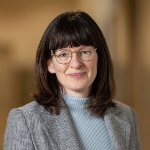What is the concentration of atomic oxygen in Venus' atmosphere? What makes planetary nebulae, which form when stars die, so fascinating? What role do magnetic fields play in the birth of galaxies? These are just some of the scientific questions that the flying observatory SOFIA helped to answer.
The Stratospheric Observatory for Infrared Astronomy SOFIA explored space from November 2010 to September 2022. The observation flights are the result of a joint German-American project between the space agencies DLR and NASA. Scientific operations on the German side are coordinated by the German SOFIA Institute at the Institute of Space Systems at the University of Stuttgart.
The SOFIA Data Center: Stuttgart researchers secure unique treasure trove of astronomical knowledge
SOFIA ceased observation operations in September 2022. But researchers will also benefit from SOFIA's wealth of knowledge in the future. A team of experts from the Institute of Space Systems (IRS) at the University of Stuttgart will set up the SOFIA Data Center (SDC) over the next five years. The project is funded by the DLR Space Agency and the aim is to make the data collected by SOFIA available to the international astronomical community in optimal condition for further scientific use.
"We want to support German and international astronomers with our work to fully exploit SOFIA's scientific heritage and to still publish many more articles based on this archive”, says Dr. Bernhard Schulz, SDC project scientist and former SOFIA Science Mission Deputy Director. He introduced the SDC, which officially began operations in July 2024, to the scientific community on September 12, 2024, at the annual meeting of the Astronomische Gesellschaft in Cologne. The SOFIA data collection is unique because, due to the long development phases of such projects, there will not be another observatory capable of detecting far-infrared data for at least ten to twenty years. “Therefore, every photon that SOFIA has detected and whose measurement will be stored in the SDC archive is currently extremely valuable”, emphasizes Schulz.
The SDC: More than just an archive
The SDC will not only archive the SOFIA data but also process it to ensure that researchers can make the best possible scientific use of the astronomical observations in the future. For example, interference factors have to be eliminated, or the correct wavelengths assigned to different data points. The software required for this is continuously being optimized. As a result, it is standard practice at the end of the operational phase of large observatories to reprocess all data using the latest software version.
In a flying observatory like SOFIA, additional factors such as improved coordinate reconstruction - derived from the observatory's guiding cameras - or new corrections for the existing infrared-absorbing atmospheric water vapor play a role. Together with the scientific data, this technical and operational information is also stored in the SDC archive. Many former employees of the German SOFIA Institute (DSI) will be contributing their expertise to the project.
Compatible with the Virtual Observatory and in line with the American SOFIA archive
The data in the SDC archive, whose structure is based on the Virtual Observatory (VO) standard, are available free of charge to researchers from all over the world. This allows SOFIA data to be directly combined or compared with data from other observatories. The SDC will assist researchers in working with SOFIA observations through workshops, webinars, and direct one-on-one consultations.
On the American side, NASA reprocessed a portion of the data during SOFIA's approximately one-year post-operational phase and subsequently made all the data accessible through the Infrared Science Archive at the Infrared Processing and Analysis Center (IPAC), a NASA-affiliated science center. The SDC plans to collaborate with IPAC to ensure both archives are synchronized and remain in alignment.
The SDC project will end in 2029, when the SOFIA archive will be permanently transferred to the German Astronomical Center in Görlitz.
About SOFIA
SOFIA, the "Stratospheric Observatory for Infrared Astronomy" is a joint project of the Deutsches Zentrum für Luft- und Raumfahrt e.V. (DLR) and the National Aeronautics and Space Administration (NASA). It is funded on behalf of DLR by the Federal Ministry for Economic Affairs and Climate Action based on legislation by the German Parliament, the State of Baden-Württemberg and the University of Stuttgart. SOFIA activities are coordinated on the German side by the German Space Agency at DLR and carried out by the German SOFIA Institute (DSI) at the University of Stuttgart, and on the U.S. side by NASA and the Universities Space Research Association (USRA).
SOFIA at the museum
Following the end of the observation flights, the SOFIA aircraft is now on display at the Pima Air and Space Museum (PASM) in Tucson, Arizona. Guided tours of the aircraft are offered regularly from October to April, and an exhibition on the SOFIA mission is on display all year round. The mirror system of the SOFIA telescope will be on display in the foyer of the German Optical Museum (DOM) in Jena from 2027. Like the DOM, the DSI supports the PASM with models, information material and expertise.
| Contact | Dr. Bernhard Schulz, University of Stuttgart, Institute of Space Systems / German SOFIA Institute, email: bschulz@dsi.uni-stuttgart.de |
|---|
Contact

Lena Jauernig
Editor Research / Early Career Researchers


